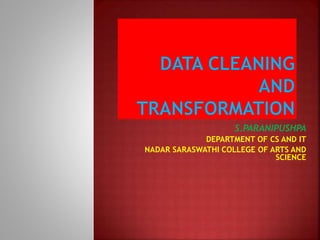Datacleaning.ppt
•Download as PPTX, PDF•
0 likes•7 views
data cleaning is a datas are clean
Report
Share
Report
Share

Recommended
Recommended
More Related Content
What's hot
What's hot (20)
Similar to Datacleaning.ppt
Similar to Datacleaning.ppt (20)
Categorical DataCategorical data represents characteristics..docx

Categorical DataCategorical data represents characteristics..docx
Exploratory Data Analysis Unit 1 ppt presentation.pptx

Exploratory Data Analysis Unit 1 ppt presentation.pptx
Unit-1-DBMS-SUN-4 everything you need to know.pptx

Unit-1-DBMS-SUN-4 everything you need to know.pptx
Data Mining DataLecture Notes for Chapter 2Introduc

Data Mining DataLecture Notes for Chapter 2Introduc
More from amuthadeepa
More from amuthadeepa (12)
Recently uploaded
Mehran University Newsletter is a Quarterly Publication from Public Relations OfficeMehran University Newsletter Vol-X, Issue-I, 2024

Mehran University Newsletter Vol-X, Issue-I, 2024Mehran University of Engineering & Technology, Jamshoro
Recently uploaded (20)
Web & Social Media Analytics Previous Year Question Paper.pdf

Web & Social Media Analytics Previous Year Question Paper.pdf
Mixin Classes in Odoo 17 How to Extend Models Using Mixin Classes

Mixin Classes in Odoo 17 How to Extend Models Using Mixin Classes
Measures of Dispersion and Variability: Range, QD, AD and SD

Measures of Dispersion and Variability: Range, QD, AD and SD
Beyond the EU: DORA and NIS 2 Directive's Global Impact

Beyond the EU: DORA and NIS 2 Directive's Global Impact
ICT role in 21st century education and it's challenges.

ICT role in 21st century education and it's challenges.
Measures of Central Tendency: Mean, Median and Mode

Measures of Central Tendency: Mean, Median and Mode
On National Teacher Day, meet the 2024-25 Kenan Fellows

On National Teacher Day, meet the 2024-25 Kenan Fellows
Unit-IV; Professional Sales Representative (PSR).pptx

Unit-IV; Professional Sales Representative (PSR).pptx
Role Of Transgenic Animal In Target Validation-1.pptx

Role Of Transgenic Animal In Target Validation-1.pptx
Z Score,T Score, Percential Rank and Box Plot Graph

Z Score,T Score, Percential Rank and Box Plot Graph
Energy Resources. ( B. Pharmacy, 1st Year, Sem-II) Natural Resources

Energy Resources. ( B. Pharmacy, 1st Year, Sem-II) Natural Resources
Datacleaning.ppt
- 1. S.PARANIPUSHPA DEPARTMENT OF CS AND IT NADAR SARASWATHI COLLEGE OF ARTS AND SCIENCE
- 2. Invalid values: Some datasets have well-known values, e.g. gender must only have “F” (Female) and “M” (Male). In this case it’s easy to detect wrong values. Formats: The most common issue. It’s possible to get values in different formats like a name written as “Name, Surname” or “Surname, Name”. Attribute dependencies: When the value of a feature depends on the value of another feature. For example, if we have some school data, the “number of students” is related to whether the person “is teacher?”. If someone is not a teacher he/she can’t have any students.
- 3. Uniqueness: It’s possible to find repeated data in features that only allow unique values. For example, we can’t have two products with the same identifier. Missing values: Some features in the dataset may have blank or null values. Misspellings: Incorrectly written values. Misfielded values: When a feature contains the values of another.
- 5. Visualisation: Visualising all the values of each feature, or taking a random sample to see if it’s right. Outlier analysis: Analysing if data can be a human error. E.g. a 300 year old person in the “age” feature. Validation code: It’s possible to create a code that checks if the data is right. For example, in uniqueness, checking if the length of the data is the same as the length of the vector of unique values. We can apply many methods to fix the different
- 6. Indicator variables: This technique converts categorical data into boolean values by creating indicator variables. If we have more than two values (n) we have to create n-1 columns.
- 7. Data Binning or Bucketing: A pre-processing technique used to reduce the effects of minor observation errors. The sample is divided into intervals and replaced by categorical values.
- 8. Centering & Scaling: We can Centre the data of one feature by substracting the mean to all values. To scale the data, we should divide the centered feature by the standard deviation:
- 9. Other techniques: For example, we can group the outliers with the same value or replace the value with the number of times that it appears in the feature:
- 11. THANK YOU